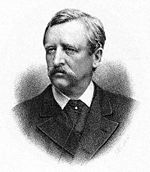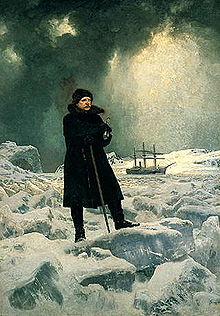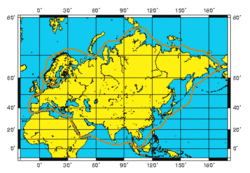- Adolf Erik Nordenskiöld
-
For other members of Nordenskiöld family, see Nordenskiöld (surname).The title of this article contains the character ö. Where it is unavailable or not desired, the name may be represented as Adolf Erik Nordenskiold.
Adolf Erik Nordenskiöld 
Adolf Erik NordenskiöldBorn 18 November 1832
Helsinki, FinlandDied 12 August 1901 (aged 68)
Dalbyö, Södermanland, SwedenNationality Finland Sweden Fields Geology, mineralogy Freiherr Nils Adolf Erik Nordenskiöld (Swedish pronunciation: [ˈnuːrdenʃœld]), also known as A. E. Nordenskioeld (18 November 1832, Helsinki, Finland – 12 August 1901, Dalbyö,[1] Södermanland, Sweden) was a Finnish baron, geologist, mineralogist and arctic explorer of Finnish-Swedish origin. He was a member of the prominent Finland-Swedish Nordenskiöld family of scientists. Born in the Grand Duchy of Finland at the time it was a part of the Russian Empire, he was later, due to his political activity, forced to live in political exile in Sweden, where he later would become a member of the Parliament of Sweden and the Swedish Academy. He is most remembered for the Vega expedition along the northern coast of Eurasia, which he led in 1878-1879. This was the first complete crossing of the Northeast Passage.
Contents
Nordenskiöld family
The Nordenskiölds were an old Finnish-Swedish family, and members of the nobility. Nordenskiöld's father, Nils Gustav Nordenskiöld, was a prominent Finnish mineralogist, civil servant, and traveller. He was also a member of the Russian Academy of Sciences.
Adolf Erik was the father of Gustaf Nordenskiöld (explorer of Mesa Verde) and Erland Nordenskiöld (ethnographer of South America) and maternal uncle of Nils Otto Gustaf Nordenskjöld (another polar explorer [note the different spelling of the latter's family name]).[2]
Early life and education
Nordenskiöld was born in 1832 in Helsinki, the capital of Finland, but he spent his early youth on the family estate in Mäntsälä. He went to school in Porvoo, a small town on the south coast of Finland. He then entered the Imperial Alexander University in Helsinki in 1849 where he studied mathematics, geology, and applied himself especially to chemistry and mineralogy. He received his masters degree in 1853. Two years later, he published his dissertation, entitled "Om grafitens och chondroditens kristallformer" (On the crystal forms of the graphite and chondrodite).
Upon his graduation, in 1853, Nordenskiöld accompanied his father to the Ural Mountains and studied the iron and copper mines at Tagilsk; on his return he received minor appointments both at the university and the mining office.
Political activity and exile
 Adolf Erik Nordenskiöld
Adolf Erik Nordenskiöld
In 1856, Nordenskiöld was appointed Docent in Mineralogy at the university. However, for political reasons he had to flee in the following year to Sweden, where he was called to the office of Director of the Mineralogical Department of the Swedish Museum of Natural History and to a professorship in Mineralogy at the Swedish Academy of Sciences. He married in 1863 Anna Maria Mannerheim, the aunt of Carl Gustaf Emil Mannerheim.
Having studied under Runeberg he belonged to Liberal, anti-tsarist circles that agitated for Finland's liberation from Russia by the Swedes during the Crimean War; and an unguarded speech at a convivial entertainment in 1855 drew the attention of the Imperial Russian authorities to his political views, and led to a dismissal from the university.
He then visited Berlin, continuing his mineralogical studies, and in 1856 obtained a travelling stipend from the university in Helsinki and planned to expend it in geological research in Siberia and Kamchatka. Upon returning he took his master's and doctor's degree in 1857 as a scholar of chemistry and geology, specializing in iron and copper-mining. He then aroused the suspicion of the authorities again, so that he was forced to leave Finland, practically as a political refugee, and was deprived of the right of ever holding office in the university of Finland.
Settling in Stockholm, and Arctic exploration
As Nordenskiöld spoke Swedish as his mother tongue, a natural place for him to settle was nearby Stockholm. He soon received an offer from Otto Torell, the geologist, to accompany him on an expedition to Spitsbergen. To the observations of Torell on glacial phenomena Nordenskiöld added the discovery at Bell Sound of remains of Tertiary plants, and on the return of the expedition he received the appointment of professor and curator of the mineralogical department of the Swedish Museum of Natural History (Naturhistoriska Riksmuseet).
Nordenskiöld's participation in three geological expeditions to Spitsbergen, followed by longer Arctic explorations in 1867, 1870, 1872 and 1875, led him to attempt the discovery of the long-sought Northeast Passage. This he accomplished in the voyage of the Vega, navigating for the first time the northern coasts of Europe and Asia. Starting from Karlskrona on 22 June 1878, the Vega doubled Cape Chelyuskin in the following August, and after being frozen in at the end of September near the Bering Strait, completed the voyage successfully in the following summer. He edited a monumental record of the expedition in five volumes, and himself wrote a more popular summary in two volumes.
On his return to Sweden he received an enthusiastic welcome, and in April 1880 was made a baron and a commander of the Order of the North Star. In 1883, he visited the east coast of Greenland for the second time, and succeeded in taking his ship through the great ice barrier, a feat attempted in vain during more than three centuries. The captain on the Vega expedition, Louis Palander, was made a nobility at the same time, and took the name Palander af Vega.
In 1893, Baron Nordenskiöld was elected to the 12th chair of the Swedish Academy.
The Historian of Early Cartography
As an explorer, Nordenskiöld was naturally interested in the history of Arctic exploration, especially as evidenced in old maps. This interest in turn led him to collect and systematically study early maps. He is today remembered for two substantial monographs, which both included many facsimiles, on early printed atlases and geographical mapping and medieval marine charts, respectively the Facsimile-Atlas to the Early History of Cartography (1889)[3] and Periplus (1897).[4]
He left his huge personal collection of early maps to the University of Helsinki, and it was inscribed on UNESCO’s Memory of the World Register in 1997.[5]
Honors
The Laptev Sea had been originally named "Nordenskiöld Sea" (Russian: мо́ре Норденшельда), after this Arctic explorer. The Nordenskiöld Archipelago and the Nordenskiöld crater on Mars were also named in his honor.
Expeditions
- In 1858, 1861, and 1864 he went with expeditions to Spitsbergen, and in 1868 he went in a small vessel farther north than any vessel had ever been in the Eastern hemisphere. In 1861 he took part in Torell's second Spitsbergen expedition and in 1864 he led the expedition promoted by the Royal Swedish Academy of Sciences.
- In 1870, he visited Greenland and in 1871 went again to Spitsbergen and stayed there all winter, nearly starving to death.
- In the expeditions of 1872 and 1875, he headed a well-organized expedition in the iron steamer Sofia, and reached the highest northern latitude (+81° 42 min) then attained in the eastern hemisphere.
- In 1875, he went to the Yenisei River in Siberia, in a small vessel, which he sent back while he went up the river and returned home by land. The next year he went to the United States and was a juror at the Centennial Exhibition.
- In 1878 he sailed around the north coast of Asia, returning home by way of the Bering Strait, being the first to make the whole length of the Northeast passage. This he accomplished in the voyage of the Vega, navigating for the first time the northern coasts of Europe and Asia. Starting from Karlskrona on 22 June 1878, the Vega doubled Cape Chelyuskin in the following August, and after being frozen in at the end of September near the Bering Strait, completed the voyage successfully in the following summer.
- In 1882-1883 - 2nd Dickson Expedition ("Den andra Dicksonska Expeditionen till Grönland"[6]), he took the vessel "Sofia" to the Disko Bay where, together with three Saami, he made an expedition to the inland ice sheet. He expected the interiour of Greenland to be ice-free and perhaps covered in forests. Nordenskiöld quickly had to give up due to technical problems, but the Saami penetrated 230 kilometres eastward before returning. On the east coast of Greenland, the expedition penetrated the great ice barrier - as the first after 300 years of attempts - and landed at Ammasalik (Kung Oscars Hamn) 65° 37' N, i.e. only slightly to the north of where Wilhelm August Graah was forced to turn his Umiak expedition round in 1830.
External links
- Biographical entry on Pegasos, the Nordic authors site
- Characters from real life who appeared in Carl Barks's and Don Rosa's stories
- A. E. Nordenskiöld and his Collections in Helsinki University Library
- Map collection at UNESCO site
See also
- Adolf Erik Nordenskiöld was recently selected as the main motif for a high value commemorative coin, the €10 Adolf Erik Nordenskiöld and Northeast Passage commemorative coin, minted in 2007. This issue celebrates the 175th anniversary of the birth of the Finnish explorer and of his discovery of the Northeast Passage. The issue is a part of the European series with the eurostar mintmark, which in 2007 celebrates European achievements in history. The obverse features an abstract portrait of Nordenskiöld at the helm of his ship. The reverse is dominated by a pattern resembling the labyrinth formed by adjacent ice floats.
Notes
- ^ Dalbyö is a farm in Västerljung, Trosa Municipality
- ^ Nils Otto Gustaf Nordenskjöld's parents were cousins—Otto Gustaf Nordenskjöld (born in 1831 in Hässleby, Sweden) and Anna Elisabet Sofia Nordenskiöld (born in 1841 in Finland), who was the sister of Adolf Erik Nordenskiöld. The Swedish side of the family used the spelling "Nordenskjöld", whereas the Finnish side of the family used the "Nordenskiöld" spelling.
- ^ Adolf Erik Nordenskiöld, Facsimile-Atlas to the Early History of Cartography with Reproductions of the Most Important Maps Printed in the XV and XVI Centuries, trans. Johan Adolf Ekelöf (Stockholm, 1889; reprinted, New York: Dover, 1973).
- ^ Adolf Erik Nordenskiöld, Periplus: An Essay on the Early History of Charts and Sailing Directions',' trans. Francis A. Bather (Stockholm: P. A. Norstedt, 1897).
- ^ "The A.E. Nordenskiöld Collection". UNESCO Memory of the World Programme. 2008-06-05. http://portal.unesco.org/ci/en/ev.php-URL_ID=23237&URL_DO=DO_TOPIC&URL_SECTION=201.html. Retrieved 2009-12-15.
- ^ Nordenskiöld, A.E. (1885) (in Swedish). Den andra Dicksonska Expeditionen till Grönland, dess inre isöken och dess Ostkust utförd år 1883 under befäl af A. E. Nordenskiöld [The second Dickson Expedition to Greenland, its inner Ice Desert and its East Coast conducted 1883 under command of A. E. Nordenskiöld]. Stockholm: F. & G. Beijers Förlag. http://runeberg.org/polexp1883/.
References
 This article incorporates text from a publication now in the public domain: Chisholm, Hugh, ed (1911). "Nils Adolf Erik, Baron Nordenskiold". Encyclopædia Britannica (11th ed.). Cambridge University Press. http://www.1911encyclopedia.org/Nils_Adolf_Erik,_Baron_Nordenskiold.
This article incorporates text from a publication now in the public domain: Chisholm, Hugh, ed (1911). "Nils Adolf Erik, Baron Nordenskiold". Encyclopædia Britannica (11th ed.). Cambridge University Press. http://www.1911encyclopedia.org/Nils_Adolf_Erik,_Baron_Nordenskiold.
Preceded by
Anders AndersonSwedish Academy,
Seat No 12
1893-1901Succeeded by
Gustaf RetziusCategories:- 1832 births
- 1901 deaths
- People from Helsinki
- Swedish-speaking Finns
- Explorers of the Arctic
- 19th-century explorers
- Finnish explorers
- Finnish mineralogists
- Finnish sailors
- Finnish scientists
- Members of the Swedish Academy
- Members of the Royal Swedish Academy of Sciences
- Members of the lower house of the parliament of Sweden
- Swedish explorers
- Swedish nobility
- Chukchi Sea
- East Siberian Sea
- Laptev Sea
- Kara Sea
Wikimedia Foundation. 2010.




